Liz Grandchamp shares a mix of family recipes and new creations with these dishes inspired by the traditional Italian Christmas Eve dinner.
Recipes by Liz Grandchamp | Photography by Forrest Mason
Liz Grandchamp has worked in kitchens her entire life. She moved to Raleigh in 2007 to attend North Carolina State University, followed by the Culinary Institute of America in St. Helena, California. Here in Raleigh, she’s worked front of house at Crawford & Son, Locals Oyster Bar, and Oakwood Pizza Box, and has consulted for Standard Beer + Food as well as Plates Kitchen.
One of Grandchamp’s family traditions is the Feast of the Seven Fishes. It’s an Italian-American meal typically served on Christmas Eve that incorporates a variety of fish and other seafood. “It’s something my parents grew up doing in Rhode Island,” she says. Here, she interpreted a menu that combines Italian classics with some new inventions to share with WALTER.
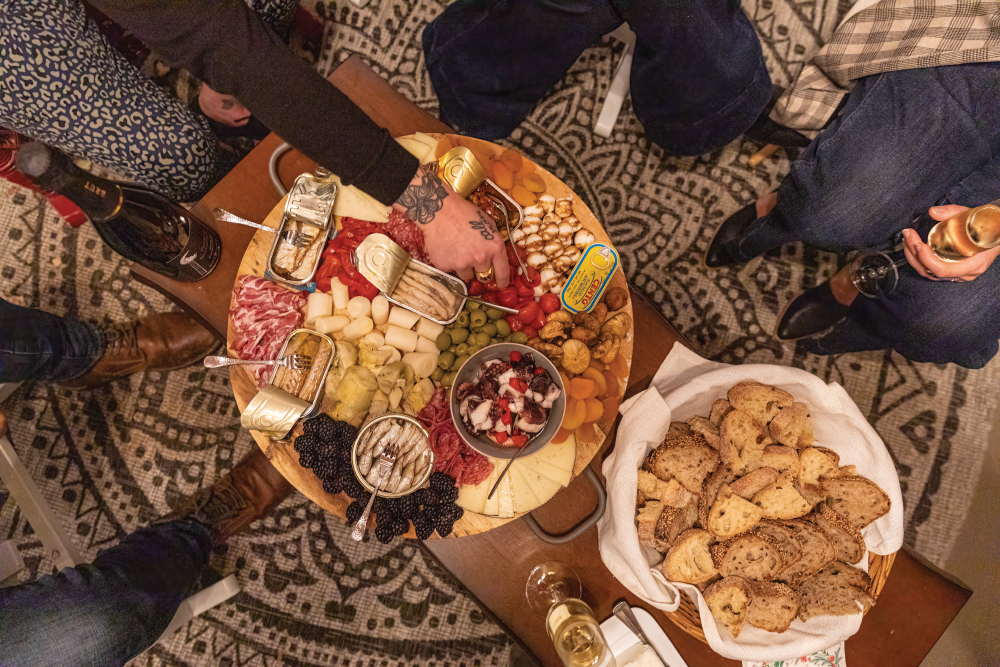
How to build an Italian Antipasto Board
To start, Grandchamp offered and Italian Antipasto Board. Antipasto boards are the charcuterie boards of Italians, and typically include an assortment of marinated vegetables, cheese, cured meats, dried and fresh fruit, and in this case, tinned fish. “When building an antipasto board, you want to make sure you’re hitting all the flavors: salty, sweet, sour, and bitter,” says Grandchamp. “And don’t forget to add a pop of color to your board, like roasted red peppers, olives, or salami.” She finds cured meats and sides at Alimentari at Left Bank, olives, peppers, and dried fruits at Wegmans and Whole Foods, and tinned fish at Raleigh Wine Shop. “The best way to eat tinned fish is to start with bread with butter — in this case, ciabatta from Boulted Bread and the Delitia Buffalo Milk butter from Bongiorno & Son in Lafayette Village — and then scoop your choice of fish on top,” says Grandchamp.
Recipes from Liz Grandchamp’s Feast of the Seven Fishes
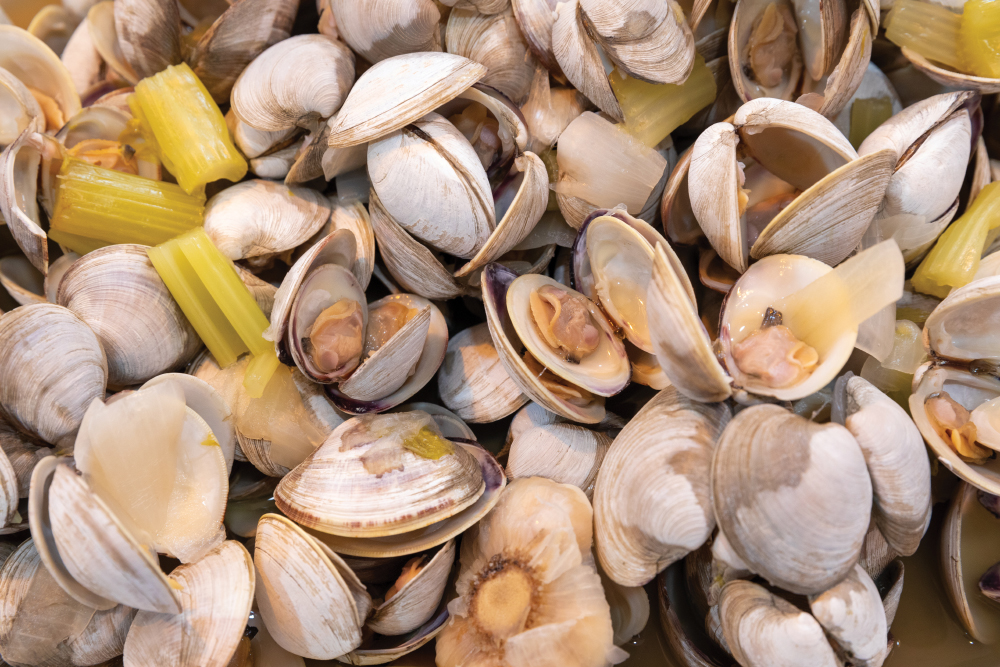
New England
Style Clams
Ingredients 2 to 3 24-ounce Narragansett beers
1 cup kosher salt
4 large white onions, roughly chopped
4 heads of garlic, cut in half
2 heads of celery, roughly chopped
100 littleneck clams (depending on the season, find at Locals Seafood or Wegmans)
1 stick butter
Directions: Fill a large stockpot halfway with water and add beer to get equal parts beer and water. Add salt and bring to a boil, then add vegetables. Lower to medium heat and cook for 20 minutes, until the vegetables are starting to get tender. Add the clams, bring to a boil and cook until clams start to open. In a separate bowl or cup, melt the butter. Strain clams and tender vegetables into a bowl, pour some butter over them, and enjoy.
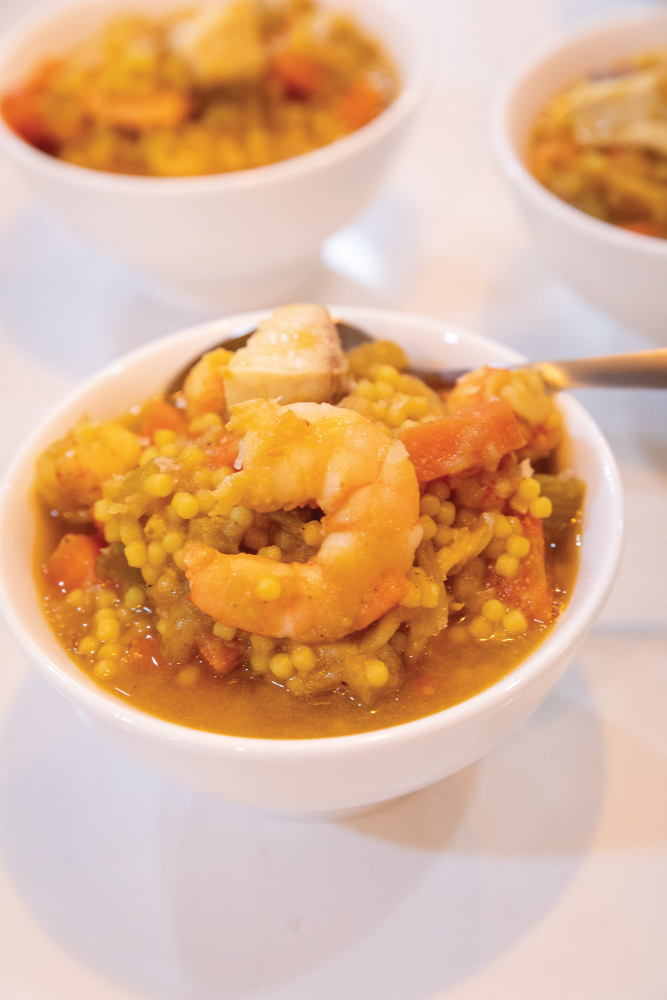
Saffron Fish Stew with Pastina and Langoustine
Ingredients
4 white onions, thinly sliced
3 leeks, thinly sliced
3 heads of garlic, thinly sliced
1 pound carrots, thinly sliced
1 whole stalk of celery, thinly sliced
2 fennel bulbs, thinly sliced
Seafood Stock (see recipe below)
2 cups pastina pasta, cooked
2 pounds uncooked shrimp
1-pound white fish (bass or flounder), cut into cubes
1 pound langoustine
12 to 15 threads of saffron
Salt and pepper to taste
1 cup Italian parsley, chopped
Directions
In a large pot, sauté onions, leeks, and garlic together, until soft and translucent (not brown). Season with salt and pepper. Add in your carrots, sauté until soft, and then add celery and fennel. Season with a little more salt and pepper. If you start to get color on your vegetables, deglaze the pot with your seafood stock. Once all the vegetables are soft, but not completely cooked through, add in half of your saffron strands and stir. Add in the remaining saffron threads and enough stock to cover the vegetables, stir, and bring to a boil. Once it’s come to a boil, cover and simmer on low. While your soup is simmering, cook your pastina in a small pot. Reserve and set aside. When you are ready to serve, remove the cover, and add in your fish. Stir until partially cooked. Add in your shrimp and langoustine. Remove from heat, and continue to stir until the shrimp is pink. Add in your pastina, season to taste, finish with chopped parsley and serve!
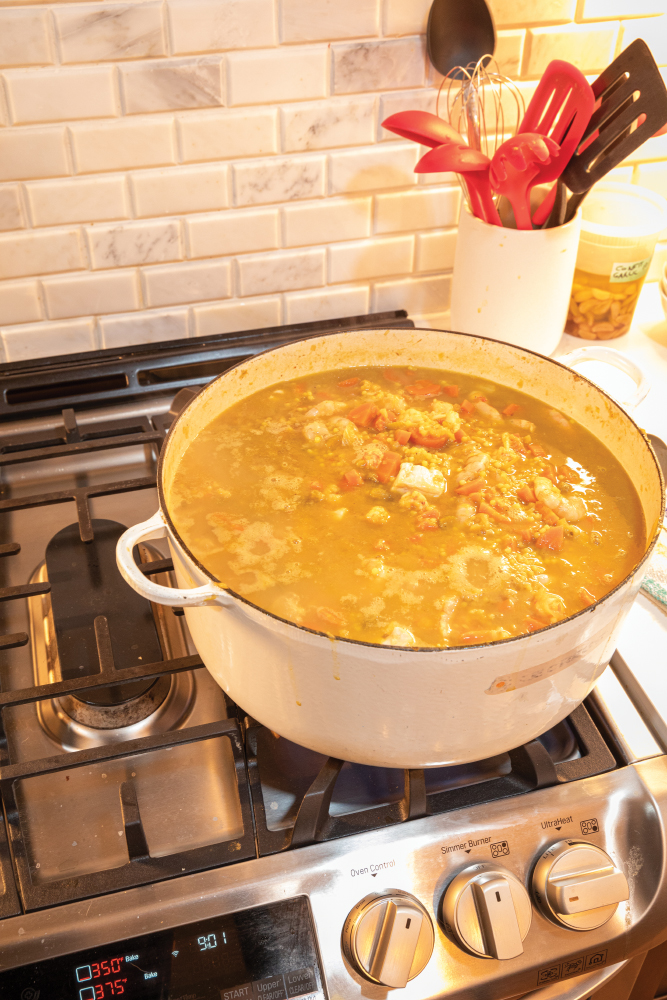
How to Make Seafood Stock
Ingredients
6 white onions, quartered
1 pound carrots, roughly chopped
2 stalks of celery, roughly chopped
2 tops and bottoms of fennel (fronds included)
3 tops and bottoms of leeks
3 to 4 spines from white, mild fish (flounder, bass)
2 pounds shells, tails, and heads of shrimp
Directions
Place all the vegetables, fish, and shells into a large pot. Fill with water and bring to a boil. Once boiling, bring down to a simmer for 2 to 4 hours (the longer it simmers, the more concentrated the flavor). Strain the stock and discard the bones. This should yield 10 to 12 quarts of stock.
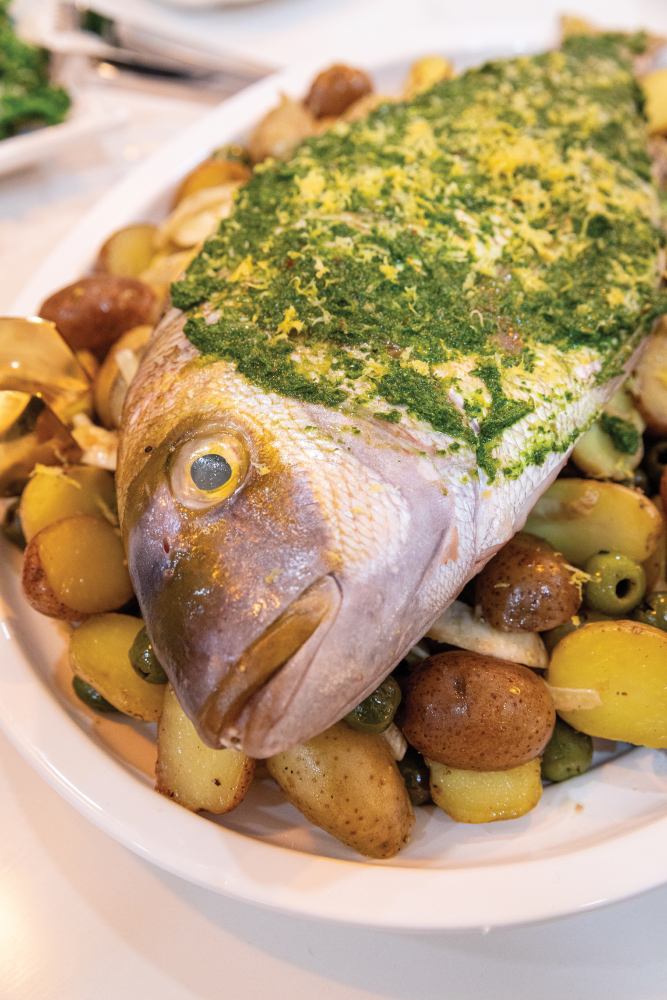
Baked Fish with Potatoes, Olives & Salsa Verde
Ingredients
3 to 4 whole pound Pink Porgy (you can also use snapper, sea bass, or another thick, white fish)
1 bag rainbow baby potatoes
1 cup salt
1 cup pitted Castelvetrano olives
4 lemons, sliced into wheels
Salt and pepper to taste
Head of garlic, peeled and roasted (optional)
Salsa Verde (recipe below)
Directions
Preheat the oven to 400 degrees. Fill a large pot with water, bring to a boil, and add the salt, then bring to boil again. Add the potatoes, and bring to a simmer for 20 minutes (or until barely fork tender). Drain into an ice bath. Score the fish skin along the sides in strokes. Rub both sides of the fish with olive oil, salt, and pepper. Set aside. Mix the potatoes, olives, and two lemons with a little bit of olive oil, salt and pepper (can add roasted garlic, if desired). Place the mixture onto the bottom of a lined baking pan, then place the fish on top. Put in the oven for 15 to 18 minutes. Check the fish: if the skin starts to get too brown, you can tent it with aluminum foil. Cook for another 3 to 4 minutes, until the flesh looks white, or you reach an internal temperature of 145 degrees. Remove from the oven and rest. Take the remainder of your lemons and arrange them on your serving platter. Spoon out the potatoes, olives, and lemons from under the fish. Place the cooked fish on your platter. Add salsa verde on top or serve as a side.
Salsa Verde Ingredients
2 bunches parsley
1 bunch dill
1 bunch cilantro
2 tablespoons capers
Zest and juice from 1 lemon
2 teaspoons red pepper flakes
Salt and pepper to taste
2 cloves of garlic, grated
Extra virgin olive oil
Directions: Add herbs to a food processor. Once slightly chopped, add in capers, lemon juice, salt, pepper, red pepper flakes, and garlic. Start to add your olive oil slowly, until you start to get a paste-like consistency. Taste and adjust seasoning. It should have bright acidity, with a briny finish.

Squid Ink Pasta with Shrimp Butter
Ingredients
3 pounds whole shrimp
1 cup salt
2 sticks unsalted butter
5 garlic cloves, peeled and roasted
2 pounds squid ink pasta (can be found at Alimentari)
Zest of 2 lemons
2 tablespoons chives
1 bunch of parsley, chopped
Directions: Remove the shells, heads, and tails from your shrimp. Place these pieces into a pot, fill with water and bring to a boil. Keep at medium-high heat for 45 minutes to an hour to create a stock, then strain out shells and set aside the stock. Fill a pot with water and cup of salt, bring to a boil. While the water comes to a boil, in a separate large saucepan, place one stick of butter on low, along with the roasted garlic. Heat on medium, and once bubbling, deglaze with your shrimp stock. You want to have a medium-thick consistency, and can always add more butter.
Take your shrimp (seasoned with salt and pepper) and place in shrimp butter. Sauté on low until slightly pink. Add your chopped parsley and lemon zest and stir. Once your water has boiled, drop in the squid ink pasta and cook 4 to 5 minutes or according to package directions. Once you have an al dente noodle, use tongs to remove the pasta and place directly into your shrimp sauce. Toss until the pasta is coated, season with salt and pepper to taste. Remove off the heat, plate and finish with chives for a pop of color.
__
This article originally appeared in the December 2021 issue of WALTER magazine.

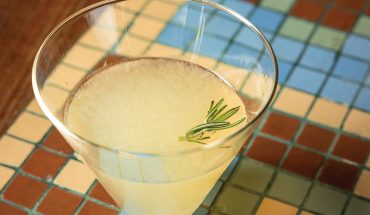
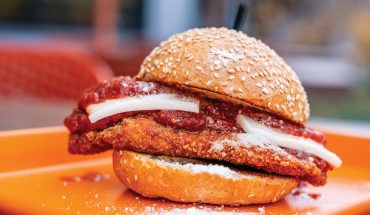
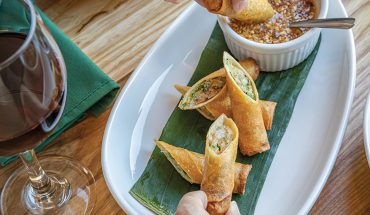
Pingback: Feast of the Seven Fishes - WALTER Magazine